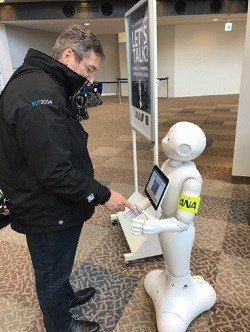It is happening so fast it cannot be stopped. From Oxford to MIT to Harvard to the World Economic Forum, they all say the same thing: The Fourth Industrial Revolution (4IR) will automate up to 47% of all jobs in the U.S. over the next 20 years. This will motivate a labor migration greater than that of the Great Depression. Even at the lower end of this range, it will be a rude awakening in what some call “a world without work.” I am a believer that it will be a full-on technological revolution for robots, machines, and cognitive systems (incorporating analytics, artificial intelligence, and machine learning).
Extreme connectivity, extreme computing power, and the new economics of automation are driving the rise of the machine.
Jobs that are labor-intensive are at risk, especially when the cost of a robot is significantly lower than a human salary. For an employer, the cost of an employee (including salary, healthcare, and other benefits) can total $45,000 USD a year. A robot can do exactly the same work for much less and be more “reliable” in the process, requiring maintenance rather than benefits (robots don’t take sick days). It can also produce the same product or service at the same (or faster) rate in exactly the same way, every time.
The more human incomes increase and benefit costs soar, the wider the crossover point grows, or if you will, the alligator jaws widen. This is the economic argument, not the moral one. The two arguments need to be solved, conjunctively.
Machine-to-machine communication is driving vast increases in asset utilization and efficiency, more accurate information, and greater safety. For example, by the end of 2020, there will be approximately 53 million smart meters throughout the U.K. Will it make sense, or even be feasible, for a human to be dispatched four times a year to read and record the information and hand this to another human only to be correct 80% of the time?
Engine monitoring—planes, trains, and automobiles—is a great advancement. Sensors in various locations can gather information about the engine. Fuel consumption, engine performance, irregularities, preventative maintenance, and more—all of this information is sent in real time to the operator for correction, or to machines for analysis, or to ground crews to ensure parts and labor are immediately available to get the asset performing again.
The same goes for robotic handling, welding, assembly, dispensing, and processing. Over the last 10 years, the prevalence of industrial robots in welding has grown by nearly 100%. At the same time, U.S. manufacturing jobs have fallen 15%. In the auto industry today, one robot is employed for every 10 humans.
Numbers are reaching critical mass. Researchers predict that by 2025, Japan will have 1 million industrial robots installed and there will be more than 7 million unmanned aircraft (or “civilian drones”) flying the U.S. skies. Over the next 10 years, there will be 60 million robots in the world. That’s the equivalent of the entire U.K. population!
The rise of machines is real and reaching scale and the future of employment is being redefined. The business, ethical, and policy questions on how we treat a machine versus a human need to enter public discourse. As machines get smarter, more perceptive, better at manipulation, more creative and socially intelligent, more jobs become vulnerable.

Here I am talking to a robot while checking in for a flight from Tokyo to San Francisco. The robot was useless. I tried to use one of those passport scanners and it could not read my passport, so I ended up speaking to a human and printing my ticket.
The effects of the 4IR will be extended far beyond the workplace. In my next blog, I will explore the potential impacts it may have on individuals.
To read more, download The Golden Age of Innovation.
I’ll be taking this message on the road for Enterprise World. Learn more.
I’d love to hear your thoughts. To provide feedback, or if you would like to see additional topics covered in future publications, please add your comment below.




